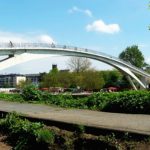Muelheim is rich in culture, both in population as well as in cultural settings like concert halls. It is home to the creative scene of TV and game producers in loft-style pulling fancy shops and bars into the neighborhood.



Photos f.l.t.r.: Graf-Adolf-Straße_Köln-Mülheim Von Eigenes Werk - Eigenes Werk GFDL, CC 0, Köln-Mülheim_Mülheimer_Freiheit_Kirchstraße von HOWI - Horsch, Willy (Eigenes Werk) CC BY 3.0 - all via Wikimeida Commons
The municipality Mülheim, colloquially also called "Müllem", is located in the north of Cologne on the right side of the Rhine. Mülheim was named in pre-industrial times after the mills on the lower reaches of the stream Strundenerbach. In 1914 Mülheim was incorporated into the city of Cologne.
Already in the high Middle Ages Mülheim received its freedom and city rights. Mülheim rivaled for a long time with Cologne, which called the other side of the Rhine derogatory as "Schäl Sick" and still does. At that time, Cologne had the Mülheim fortifications razed to the ground several times.
In the 1970s, up-and-coming industrial companies settled in Mülheim because there was a lack of suitable space in Cologne. Since Mülheim had become a railway junction and had a port, large works could develop there. During this time, the proportion of migrants, especially from Turkey, rose considerably.
During the 1980s and 1990s, many Mülheim factories had to close and left a working-class district with fairly high unemployment. However, this has changed again due to numerous attractive relocations of young creative companies from the innovative and forward-looking media and IT industries, and the old industrial facilities have been converted into loft-style office buildings.
Mühlheim is rich in cultural settings: Kulturbunker Mülheim, Siedlung Kunstfeld of 1920, the Stadtgarten with the Stadthalle, and the event halls E-Werk and Palladium regularly offer concerts and theater.
The Wiener Platz is the epicenter of everyday life and an important transport hub in Mülheim for both train drivers and motorists. The busy Mülheim Bridge connects the district with Riehl on the left bank of the Rhine.
The Keupstraße is nationwide known as a center of Turkish business life. Numerous restaurants and cafés show that Turkish cuisine can do more than kebabs and kebabs.
In the neighboring Schanzenstraße there are TV studios in which Stefan Raab ("TV Total", "Schlag den Raab" etc.), Harald Schmidt ("The Harald Schmidt Show"), Anke Engelke ("Ladykracher"), Bastian Pastewka ("Pastewka") and Christof Maria Herbst ("Stromberg") made and still make Germany-wide known TV shows.
The Bergisch Gladbacher Strasse is one of the central shopping streets, Düsseldorfer Strasse, Dünnwalder Strasse as well as Berliner Strasse towards the North and the river banks convince with very nice old building from the early 19 th and the Böcking park.
In Mülheim, there is a small, steep pedestrian bridge over the Rhine with the sweet name "Katzenbuckel" (cat back). Because it is almost completely surrounded by old industrial plants, not too many visitors get lost on this small jetty. Nevertheless, it offers one of the most beautiful panoramic views over Cologne.
A gruesome anecdote is that the serial killer Peter Kürten was born in 1883 in Cologne-Mülheim. He entered the crime story as the "Vampire of Dusseldorf": he drank the blood of his victims.


















Photos f.l.t.r.: E-Werk,_Köln-Mülheim Von G. Friedrich - Eigenes Werk, CC BY 3.0, E-Werk-Köln-Mülheim-Schanzenstraße Von HOWI - Horsch, Willy - Selbst fotografiert, CC-BY-SA 4.0, Koeln-Muelheim_Stadthalle CC0, Keupstrasse von A.Savin (Wikimedia Commons · WikiPhotoSpace) (Eigenes Werk) CC BY-SA 3.0, Felten_&_Guilleaume_Köln-Mühlheim_Haupteingang_Schanzenstraße von HOWI - Horsch, Willy (Eigenes Werk) CC BY 3.0, Köln_Schanzenstr._28_03 Von Nicola - Eigenes Werk, CC BY-SA 3.0, Fabrikhalle,_Gebäude_170,_Schanzenstraße_41,_Köln-3119 Von Raimond Spekking CC-BY-SA 4.0, Wiener_Platz,_Weihnachtsmarkt,_Köln-Mülheim Von G. Friedrich - Eigenes Werk, CC BY 3.0, Wiener_Platz_Galerie,_Köln-Mülheim von G. Friedrich (Eigenes Werk) CC BY 3.0, Köln-Mülheim_Wiener_Platz_Kreissparkasse_2011 Von 4028mdk09 - Eigenes Werk, CC BY-SA 3.0, Köln-Mülheim_Rhodiusstraße_10_Front Von HOWI - Horsch, Willy - Eigenes Werk, CC BY 3.0, Köln-Mülheim_Präses-Richter-Platz Von HOWI - Horsch, Willy - Eigenes Werk, CC BY 3.0, Vincenzstrasse_23-27_Köln-Mülheim von Eigenes Werk (Eigenes Werk) GFDL, Muelheimkath02 Von A.Savin (Wikimedia Commons · WikiPhotoSpace) - Eigenes Werk, CC BY-SA 3.0, Katzenkopfbrücke Von Chiara45 - Eigenes Werk, CC BY-SA 3.0, Köln-Mülheimer-Hafenbrücke Von HOWI - Eigenes Werk, CC BY 3.0, Köln_Buchholzstraße_Allee von Nicola (Eigenes Werk) CC BY-SA 3.0, Köln_Düsseldorfer_Str._54 Von Nicola - Eigenes Werk, CC BY-SA 3.0 - all via Wikimedia Commons
